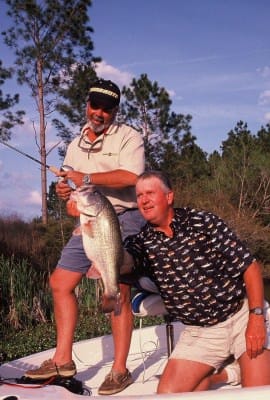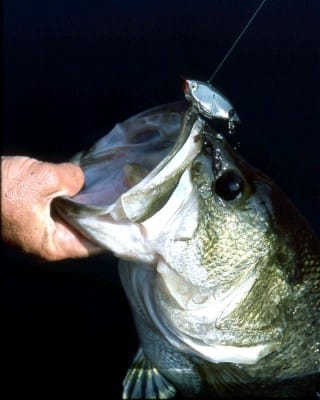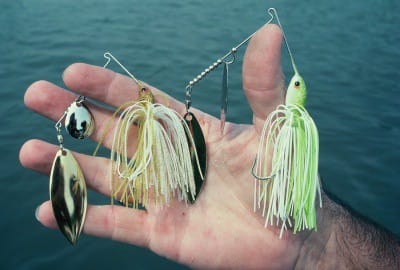
Fishing during the change of seasons is special, particularly when winter gives way to spring and when summer’s grip relents to fall. Mornings are golden promises, with sometimes a touch of frost on a boat’s glistening gunnel. Rivers run as liquid ice, with water so transparent it passes over rocks like molten crystal. Steam rises readily from the water’s surface and lingers at human speech. The sky can be as clear-blue as the Gulf Stream one moment, then quickly turn as dark and menacing as the sea in a tempest.
Seasonal change is in the wind, and fish are making the most of it, whether it is from increasing metoblishing this time of year or taking advantage of summer’s final bounty in the fall. It is a unique time for bass anglers, one that affords some of the top fishing of the year. But for fishermen bent on consistent success, a well-defined arsenal of lures best delivers the kind of fishing action for which these seasonal changes are so well known.
While there are no sure things in fishing, much as in life, the following lures have consistently scored for me over a lifetime of fishing. One important key in using these lures is to be versatile. Should one lure not produce results, try another. If you’ve fished one plug fast and had no strikes, slow it down. If you’ve used large, bright artificials without success, try smaller, darker lures, and work different structures, cover and water types. Keep in mind that autumn and spring fish frequently are feeding machines. So by presenting the right lure, in the right manner, fish usually will respond as you dream they should.
In many waters throughout America, autumn is the season of the shad. Young-of-the-year threadfin and gizzard shad have grown quickly through summer, and by autumn are in huge quivering schools that offer easy targets for bass. Moreover, big shad schools commonly are on the move, especially in reservoirs and large rivers. These mid-size baitfish commonly move downstream in rivers, and to the lower reaches of reservoirs, and school bass stay with them through their migrations. When waters start to warm in the spring, shad are again the key to good fishing.
Sinking, shad-like lipless crankbaits such as the venerable Bill Lewis “Rat-L-Trap,” or the Cotton Cordell “Spot” or “Gay Blade” score well on autumn largemouths holding around shad schools. I like silver, white and chrome-blue colors. Use lures that imitate the size shad bass are feeding on, which typically are 2- to 3-inches in length. Lure weight also is important, not only in terms of how deep it runs during the retrieve, but also how far the bait can be cast. Often long casts are required to “reach” fast-moving shad and bass schools.

Compact spoons are excellent for open-water bass. Silver and copper spoons are excellent, and ones with hammered finishes have exceptional and attractive “flash.” They also “flip-flop” enticingly as they drop through the water column, and that scores well on finicky feeders, which in autumn often weigh 3 to 6 pounds. A stop-and-go retrieve works with spoons, because when the lure pauses in its forward motion, it flutter-falls toward bottom flashing and tumbling like an injured minnow. Wind-blown points are good places for casting spoons, as are rock bars, riprap banks, the mouths of creeks and rivers.
Good spoons for school bass measure 1- to 3-inches long. Some of the best are the Mepps Syclops, Acme KastMaster, original Eppinger Dardevle, Bomber Slab Spoon, Cotton Cordell C.C. Spoon and the Little Cleo by Acme Tackle. Sometimes heavyweight largemouths key on pods of larger-than-average shad and shiners as they migrate in fall. When they do, a giant spoon can be just the ticket to lunker largemouths.
Tandem-blade spinnerbaits allow autumn anglers to work a variety of waters where feeding largemouths may be found. Spinnerbaits can be “buzzed” across still-green weed beds or slowly bumped through stump fields and over riprap. A good all-around lure weight is 3/8-ounce, and good ones have full rubber or other synthetic skirts with contrasting colors like black-and-white, chartreuse-and-black and blue-and-white. Double willowleaf spinnerbait blades work well, because their fast, tight-spinning actions perfectly imitate autumn baitfish. In waters where there are silvery shad, chrome blades are great, especially hammered or “diamond” blades. Bronze, willowleaf blades do well where golden shiners abound. If you’re in doubt about the resident baitfish, try a spinnerbait having one bronze and one silver blade.
The Booyah Super Shad may be the ultimate imitator of shad, as far as spinnerbaits go. It has four willowleaf blades for lots of flash and attraction.
When big baitfish are around, oversize spinnerbaits with outsize blades work great in “matching the hatch.” Spinnerbaits featuring giant interchangeable blades that have plenty of vibration and flash to draw mega-mouth bass may be in order.

Short plastic worms often perform best for me, with 4- to 6-inch lengths preferred. A good rule of thumb is the cooler the water the shorter the worm. Many experienced anglers seldom use worms with curly tails in when the water is cold, believing they have too much inherent action. Single, “straight-tail” models are ideal. Yum’s Dinger worm is a good choice, as is Bass Assassin’s Twitch Assassin. These plastic lures can be rigged weedless Texas or Carolina style, or even fished off a drop-shot rig. Fishing them on stand-up jig heads, 1/8- to 1/2-ounce (depending on water depth) is a good tactic, too. Slow retrieves normally are most productive, especially when fished near drop-offs and deep cover in 6- to 15-feet of water.
No bass angler’s lure arsenal is complete without quality jigs, and tube models get the nod. They can be used well with standard tube jig heads, from 1/8- to 1/2-ounce (size depending on water depth worked). They also can be rigged weedless with a small slip weight and finesse style hook, like the deadly Eagle Claw HP. Good tubes are made by many companies. Grubs are tops, too, and Lunker City’s Fin-S-Fish has become one of the most dependable ones, especially fitted to a Lunker City Fin-S-Head jig head.
One of the surest tactics for catching fall bass occurs late in autumn when weed beds begin to die. As lush, forage-fish holding weeds turn brown, fish leave them. Usually shallower weed beds die first, so minnows and bass head deeper, repositioning around still-green weeds. Locate such healthy vegetation when most shallow weeds have died and turned brown, and it’s a good bet you’ll be into bass in a big way. Spinnerbaits work well in deep weeds, as do plastic worms and weedless bass or flippin’ jigs. Use your fathometer and sense of feel in fishing lures to maintain proper weed bed/lure contact. Those same weed beds are again bass magnets this time of year as spring’s warming temperature bring on new growth. A slow-rolled spinnerbait or methodical probing with plastics or jigs can produce huge springtime catches.
Another outstanding lure for working deep weeds is a soft plastic jerk bait rigged with a small slip-weight, Carolina fashion. Keep the leader short, only 12 or 18 inches, and fish the lure with long pauses between twitches. Work weed edges, over their tops, and be sure to concentrate on small turns, cuts and points in a weed line. Superb jerk baits are made by a number of companies, including Lunker City’s original, and still great, “Slug-Go.”
Fishermen who use long, floating-diving plugs can take huge bass at dawn, dusk and at night. The best plugs have short “lips” so they run near the surface. A lure having a slow-swimming action is best, which produces a surface “V”-wake that bass home-in on. To keep the lure on top, hold the rod tip high, and retrieve slowly with frequently pauses. Strikes can be bone jarring, but be sure to set the hook. Some of the best floater-divers for autumn bass include the: Rapala Original Minnow, Smithwick Rattlin’ Rogue, Bomber Long A, Cotton Cordell Red Fin and Rebel Minnow.
Finally, bear in mind that change-of-season fishing gets underway at different times depending on whether you’re fishing in the far North, the Deep South, in-between or out West. And sometimes fishing water just 150 miles north or south of an angler’s home base can make the difference in having fast autumn or spring fishing or so-so action. So choose your water carefully, and have a fishing game plan ready to follow with your lure arsenal pre-setto get wet.







